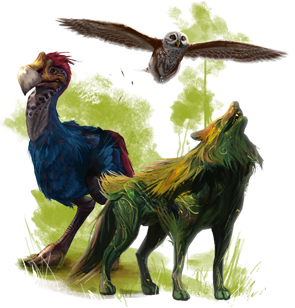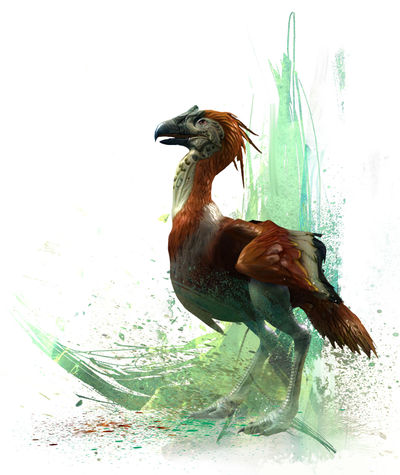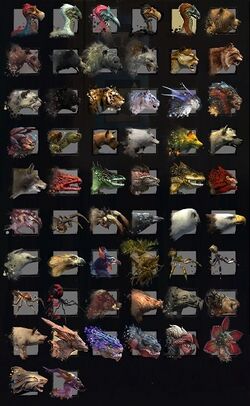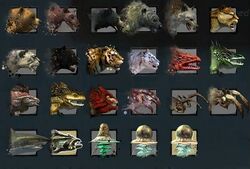Pet
Pets are the NPC allies that constitute the ranger's profession mechanic. Rangers and their pets fight as a team, and are always together. There are currently 63 unique pets in the game. They can be classified by their family, such as birds, canines, moas, bears, jellyfish, etc; and also the environment in which they can live: land, aquatic, or both (amphibious).
Pets use Artificial Intelligence to fight with the ranger and defend them, but the ranger can also give commands to the pet, such as commanding them to go attack a target before the ranger does, or stop attacking and run back to the ranger. Most importantly, the ranger has control over the pet's Beast skill, an attack unique to each pet.
By default, pets attack the same target as the ranger, or whichever enemy is attacking the ranger, but can be commanded to attack whatever target the ranger wants. If the ranger moves too far away, the pet will stop fighting and return to them. If the ranger is in the downed state, they can still use their pet to help in rallying them by finishing off the enemy or by having the pet revive them.
Pets are only available to the ranger that tamed them. They aren't shared between different ranger characters on the same account (with the exception of the Hall of Monuments pets).
Pet acquisition and the Pet Management panel[edit]
- See also: List of pet locations
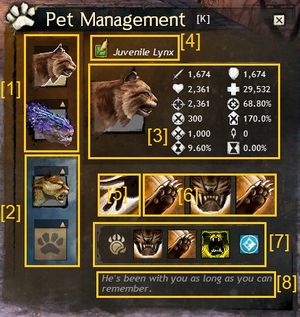
(1)The two land pets.
(2) The two aquatic pets.
(3) The pet currently being used, and their attributes.
(4) The pet's name, and the option to rename them.
(5) The pet's Beast skill.
(6) The pet's autoattack and their two pet skills.
(7) Beastmode skills and Archetype (only for Soulbeasts).
(8) Where the pet was tamed (this pet was chosen during character creation).
New rangers venture into Tyria with one single pet. During character creation, rangers must choose one from among three pets to start the game with. The choice of pet depends on the player's race. For example, a norn can choose as their first pet a Juvenile Snow Leopard, a Juvenile Brown Bear, or a Juvenile Alpine Wolf; whereas a sylvari has to choose between a Juvenile Blue Moa, a Juvenile Jungle Stalker, or a Juvenile Fern Hound. Nevertheless, this choice only determines the ranger's first pet.
As rangers venture into the world, they will find new pets for them to tame. Any friendly animal (green nameplate) whose name begins with Juvenile can be tamed (charmed) by the ranger, unless they already belong to another ranger, by approaching them and using F or double-clicking them. After a short conversation, with a description written by the mysterious Acht, the pet will join the ranger. Nearly every area in the game, including cities, contains a number of juvenile pets to tame. The list of pet locations has the location of all pets for rangers wishing to charm them all without having to search for them.
A key feature of the pet profession mechanic is the Pet Management panel, which can be accessed by clicking the current pet's portrait above the ranger's skill bar, or by using a shortcut key, which defaults to K. Once a pet is tamed, they will join the ranger and appear in the Pet Management panel, where rangers can choose to have that pet aid them in battle. In this menu, rangers can view the attributes and skills of their current pet. Each pet has three attacks (more on this below), and a unique Beast skill. They can also see the location where they tamed the pet. There is also information relevant only to ![]() soulbeasts: the pet's Archetype, and the Beastmode skills; this information is not relevant at all for
soulbeasts: the pet's Archetype, and the Beastmode skills; this information is not relevant at all for ![]() rangers nor
rangers nor ![]() druids nor
druids nor ![]() untamed.
untamed.
Through the Pet Management panel, rangers can also rename their pets. To rename a pet, a ranger has to be using that pet, open the Pet Management panel, then click on the quill icon to the left of the pet's name. Rangers have to be underwater to rename their aquatic pets and view their attributes and skills. Only the pet the ranger is currently using can be renamed, but pets will keep their name forever, or until their name is changed again.
Through the Pet Management panel, rangers can also view all the pets that exist in the game, and select from among that pool which pets —that they have already found in the world and tamed— will help them in combat. Rangers can slot four pets in this panel, the two upper slots are used for terrestrial pets, and the two lower ones for aquatic pets. Amphibious pets, such as drakes, can be placed in any of the four slots. A ranger can only tame each pet once, and should choose before entering combat which two pets they would like to use: two pets for terrestrial combat, and two pets for aquatic combat, with only one pet active at any given time. Therefore, rangers cannot have, for example, two Juvenile Polar Bears; but they can have and use two bears if they are different, such as a Juvenile Polar Bear and a Juvenile Brown Bear.
There are four pets that are cosmetic-only achievement rewards intended for players of the original Guild Wars; they can only be obtained through the Hall of Monuments: three land pets, the Juvenile Black Widow Spider, the Juvenile White Raven, and the Juvenile Black Moa; and one aquatic pet, the Juvenile Rainbow Jellyfish. They are copies of other similar pets in terms of functionality, but with a different appearance.
Pet Interface[edit]
At level 5, rangers will unlock the pet interface, which provides the ranger with some control over the actions of their pet. The pet's health bar is shown in red just above the ranger's skill bar.
| Default keybind |
Command |
|---|---|
| F1 | |
| F2 | |
| F3 | |
| F4 |
Attributes[edit]
- Primary article: Pet attributes
Pets have a set of attributes very similar to characters. Main attributes scale with the pet's level, while secondary attributes are static but can be increased through traits.
- Main attributes
- Power, determines outgoing strike damage.
- Toughness, reduces damage taken from incoming strike damage.
- Vitality, determines health.
- Precision, determines the chance for outgoing attacks to do critical damage.
- Condition Damage, determines the damage done by outgoing conditions.
- Secondary attributes
- Ferocity, determines the damage done by outgoing critical attacks.
- Healing Power, increases healing and regeneration from their own pet skills to self and allies. This attribute is 0 for all pets.
- Condition Duration, also known as Expertise, determines the duration of outgoing conditions. This attribute is 0 for all pets.
- Boon Duration, also known as Concentration, determines the duration of outgoing boons. This attribute is 0 for all pets.
These pet attributes do not scale with the ranger's own attributes, although several ranger traits can enhance some of them. A pet's level is always the same as the ranger's and their attributes scale with their level. The attributes of pets are shared by all pets in that family (see the taxonomy section), this means that all bears have the exact same vitality, toughness, power, etc.
Combat mechanics[edit]
The ranger and their pet fight as one. The profession is designed taking into account the damage and defense capabilities of both partners working together. A ranger with a defeated pet will do less damage, and enemies that were attacking the pet will now attack the ranger.
Like most NPCs, pets can be healed, be affected by boons and conditions and other effects.
Damage received by pets from most ground AoE attacks from PvE enemies is reduced by 95%, and they are immune to environmental hazards such as lava. This behavior is shared by ranger spirits and most summons in the game.
Aggro and tanking[edit]
Like all creatures and players, pets also gain aggro. Pets only generate aggro by directly attacking an enemy. A pet walking near an enemy will not draw any aggro, but the ranger will. This way, rangers are not punished for not being able to control where their pet is going to walk through. Rangers and pets enter and exit combat mode together. If the ranger commands the pet to attack an enemy, both the ranger and the pet will enter combat, even if the ranger has not attacked the enemy yet.
Pets with high vitality and/or toughness have an easier time staying alive, but do less damage than pets with high power and/or condition damage.
Rangers can also order their pet to attack a distant enemy with ![]() Attack My Target, then call their pet back with
Attack My Target, then call their pet back with ![]() Return to Me to lure the enemy to them.
Return to Me to lure the enemy to them.
When swapping a pet in combat, the pet loses all aggro, and the new pet will start with no aggro.
Attacking and Beast skill[edit]
As seen above in the Pet Interface, pets can be set to Guard or to Avoid Combat. A pet on Avoid Combat behavior will never attack enemies unless specifically commanded to do so with Attack My Target. Pets set to Guard will attack enemies that the ranger attacks, and will defend the ranger from foes that attack the ranger by attacking them.
Most pets fight in melee range, although some of them have long-range skills on a moderate recharge. Only the devourer family, the spider family, and the bristleback pet, have ranged basic attacks.
Each pet has access to 3 skills to use in combat, and an additional skill called the Beast skill. When viewing the Pet Management panel, the left-most skill is the pet's Beast skill, the other three skills are the pet's attacks. The first is their basic attack and has no recharge, the other two are their other attacks.
These 3 skills the pet uses to attack are determined and shared by their family (more about family in the taxonomy section). For example, all bears share the exact same 3 attacks:
- Slash: Slash your foe with your claws. (Bear's autoattack)
- Bite: Bite your foe to recover health. (Bear's first pet skill)
- Defy Pain: You take no damage for the next few seconds. (Bear's second pet skill)
When fighting, pets use their Artificial Intelligence to determine which of their 3 skills to use. Pets try to prioritise using their two attacks above their autoattack, but they will not waste their defensive skills. For example, bears only use Defy Pain if their health is below 75%.
What makes each pet different from each other is their Beast skill. This skill can only be activated by the ranger through the Pet Interface, and defaults to F2. For example: The Juvenile Polar Bear's Beast skill is:
And the Juvenile Murellow's (another bear) Beast skill is:
- Poison Cloud: Beast. Emit a noxious cloud that poisons and damages foes.
And the Juvenile Jacaranda's Beast skill is:
- Jacaranda's Embrace: Beast. Fire a missile that roots foes for a period of time.
- See also: list of pet skills
Downed state[edit]
When a pet's health is depleted, they enter the downed state, marked by the effect Downed. However, pet's downed state is very different from player's downed state. A downed pet will not drop on the floor. Instead, they become completely invulnerable, lose all aggro, generate no aggro, get all boons and conditions removed, cannot receive new boons and conditions, and limp back to the ranger. The pet cannot be healed by any means while downed.
Downed pets will start reviving once the ranger gets out of combat. Their health slowly recovers and, once their life bar is filled, they revive at 50% health and will continue to heal to full if the ranger remains out of combat.
A defeated pet can be revived while in combat by swapping pets, although doing this incurs as a penalty a longer recharge in ![]() Swap Pet. Aside from swapping pets, soulbeasts can fully revive their pet immediately by merging with them using Beastmode, then unmerging.
Swap Pet. Aside from swapping pets, soulbeasts can fully revive their pet immediately by merging with them using Beastmode, then unmerging.
If the ranger is downed, their pets don't automatically become downed as well, allowing downed rangers to use their pets to help them kill an enemy and rally. A downed ranger can still command their pet by using the command keybinds of the Pet Interface, which default to F1-F4, even though that interface is hidden while the ranger is downed. They also gain access to the downed skill Lick Wounds:
- Lick Wounds: Revive your pet at your location to revive you.
Swapping pets[edit]
Rangers can swap between their active pet and the other pet set in the Pet Management panel through the ![]() Swap Pet skill, which defaults to F4, allowing for quick adaptation during fights. The base recharge time for switching pets during combat is 20 seconds, and extends to 60 seconds if the original pet was defeated. It is very beneficial to swap pets before they are defeated to avoid fighting without an active pet. Pets are fully healed when using Swap Pet. Swap Pet also gives the ranger access to a second Beast skill, since the recharge of the Beast skill is not shared between pets, nor are pet skills.
Swap Pet skill, which defaults to F4, allowing for quick adaptation during fights. The base recharge time for switching pets during combat is 20 seconds, and extends to 60 seconds if the original pet was defeated. It is very beneficial to swap pets before they are defeated to avoid fighting without an active pet. Pets are fully healed when using Swap Pet. Swap Pet also gives the ranger access to a second Beast skill, since the recharge of the Beast skill is not shared between pets, nor are pet skills.
Soulbeasts cannot swap pets while merged with their pet, unless they have the trait Eternal Bond selected.
Stowing pets[edit]
Pets can also be "stowed", hidden, by clicking the ![]() Stow Pet button in the pet bar while not in combat. Stow Pet cannot use a keybind.
Stow Pet button in the pet bar while not in combat. Stow Pet cannot use a keybind.
- Stowing can be useful in tight areas where a large pet can obscure players' vision, or when taking screenshots.
- Pets automatically reappear after entering a new zone, when entering combat mode, or switching between terrestrial and underwater combat.
Taxonomy[edit]
There are multiple ways to categorize ranger pets:
- Family: Families are the main way of categorizing pets. There are currently eighteen different families, such as bird, devourer, bear, or canine. All pets within a family possess identical stats and skills, except for the Beast skill, which is determined by their species.
- Species: Families can be further subdivided into species. For example, the Juvenile Polar Bear and the Juvenile Murellow are two different species of the bear family. In short, each pet is a species, since a ranger cannot have more than one of the same pet.
- Environment: Pets can be categorized by the environment in which they live: terrestrial, aquatic, or both (amphibious). Except for felines (see table below), all members of a given family use the same environment. For example, all birds are terrestrial.
- Archetype: Pets are further categorized into different archetypes. This only affects
 Soulbeasts and has no impact on rangers not using that elite specialization or on the pets themselves.
Soulbeasts and has no impact on rangers not using that elite specialization or on the pets themselves.
Related skills[edit]
Weapon skills that affect pets[edit]
- Hunter's Shot — your pet gains 10 seconds of swiftness.
- Crippling Shot — your pet's next three attacks will inflict bleeding.
- Precision Swipe — your pet gains 1 stack of might for 5 seconds.
- Winter's Bite — your pet's next attack inflicts weakness.
- Maul — your pet gains an Attack of Opportunity (effect) for their next attack.
- Ancestral Grace — your pet gains protection for 3 seconds.
- Double Arc - your pet's next two attack will inflict poison.
Underwater weapon skills that affect pets[edit]
- Surging Maw — your pet gains 5 seconds of swiftness.
- Feeding Frenzy — your pet gains 5 seconds of fury.
Healing skills that affect pets[edit]
Utility skills that affect pets[edit]
- "Guard!"
- "Search and Rescue!"
- "Sic 'Em!"
- Signet of Renewal
- Signet of Stone
- Signet of the Hunt
- Signet of the Wild
Elite skills that affect pets[edit]
Downed skills that affect pets[edit]
Related traits[edit]
Marksmanship[edit]
- Opening Strike — You and your pet inflict vulnerability with your first strike when entering combat.
- Stoneform — Use Lesser Signet of Stone when you use an elite skill.
- Clarion Bond — Cast Lesser Call of the Wild when you swap pets.
- Moment of Clarity — Gain an attack of opportunity for you and your pet on interrupting a foe. Daze and stun durations that you inflict last longer. This trait can only grant an attack of opportunity against enemies with defiance bars once per interval.
- Predator's Onslaught — You and your pet deal increased strike damage to disabled, defiant, or movement-impaired foes. Affected conditions are stun, taunt, daze, cripple, fear, immobilize, and chilled.
Skirmishing[edit]
- Sharpened Edges — You and your pet have a chance to cause bleeding on critical hits.
Wilderness Survival[edit]
- Companion's Defense — You and your pet gain protection when you dodge roll.
- Rugged Growth — You and your pet recover health while affected by protection.
- Taste for Danger — Gain increased vitality. You and your pet gain expertise based on vitality.
- Refined Toxins — While you are above the health threshold, your strikes inflict poison. While your pet's health is above the health threshold, its strikes inflict poison.
- Shared Anguish — After you swap pets, you and your pet gain stability.
- Empathic Bond — Remove conditions when you swap pets.
- Poison Master — Upon using a Beast ability, your pet's next attack will inflict poison; your poison damage is increased.
Nature Magic[edit]
- Fortifying Bond — When you gain a boon, it is shared with your pet.
- Lingering Magic — You and your pet gain increased concentration. Regeneration you apply is more effective.
- Bountiful Hunter — You deal increased strike damage for each boon affecting you. Your pet deals increased strike damage for each boon affecting it.
- Spirited Arrival — Grant boons to nearby allies when swapping pets.
- Invigorating Bond — Beast skills heal allies around the ranger.
Beastmastery[edit]
- Pack Alpha — Your pet's attributes are improved and pet skills gain recharge reduction. Improved attributes are power, condition damage, precision, toughness, and vitality.
- Loud Whistle — While your health is above the threshold, your pet deals increased strike damage. Your pet swap gains recharge reduction.
- Pet's Prowess — Your pet moves faster and deals more damage on critical hits.
- Go for the Eyes — Nearby foes are blinded by Beast abilities.
- Potent Ally — You and your pet each grant might to the other when critically striking a foe.
- Wilting Strike — Beast abilities inflict weakness on those struck. This effect will only occur once on each target struck by an ability.
- Natural Healing — Your pet recovers health each interval.
- Beastly Warden — Beast abilities taunt nearby foes.
- Zephyr's Speed — Cast Lesser Quickening Zephyr when you swap pets.
Druid[edit]
- Cultivated Synergy - Using your heal skill, heals allies around you and your pet.
Player chatter[edit]
Your character may occasionally shout one of the following lines while interacting with their pet, depending on race and gender.
- When commanding to attack your target:
| Race | Gender | |
|---|---|---|
| Male | Female | |
| Sic 'em! (Whistle) |
Go get them! | |
| Attack! (Whistle) |
Attack! (Whistle) | |
| Attack! | Attack! (Whistle) | |
| Attack! (Whistle) |
Attack! (Whistle) | |
| Go for the throat! (Whistle) |
Attack! (Whistle) | |
- When swapping pets:
| Race | Gender | |
|---|---|---|
| Male | Female | |
| I chose you! Come here! |
I chose you! Come here! | |
| I chose you! Come here! (Whistle) |
I chose you! Come here! (Whistle) | |
| I chose you! | Next! Come here! I chose you! (Whistle) | |
| Come here, old friend! I chose you! |
I chose you! Come here! Next! | |
| I chose you! (Whistle) |
Come here! I chose you! (Whistle) | |
- On pet downed:
| Race | Gender | |
|---|---|---|
| Male | Female | |
| No! I'm coming for you! |
My pet is down! I'll revive you. Heal my pet! | |
| Pet down! My pet needs help! I'll revive you! |
Pet down! My pet needs help! I'll revive you! | |
| My pet needs help! Pet down! Don't worry! I'll revive you. |
Not my pet! Pet down! I'll revive you soon. | |
| Poor thing. Spirits, no! I'll save you. |
Poor thing. Not my pet! | |
| My pet has suffered terrible wounds! I'm here. I'll bring you back. I cannot lose my pet! My pet needs help! |
Not my pet, no! My pet is mortally wounded. | |
- On pet revival:
| Race | Gender | |
|---|---|---|
| Male | Female | |
| I'll admit. I did miss you. Good to have you back! Feeling better, are we? |
Back to the fight! | |
| Welcome back, friend. Haha, were you just playing dead? |
Welcome back! Playing dead, eh? Back to it! | |
| Were you just playing dead? Welcome back, my friend. |
Oh, so you were just playing dead? Back to the fight, my friend. | |
| Up, you! I need you. You're not done. |
There you are. All better. Get up! | |
| It's ok. Stay close. You'll not die on my watch. It's not time to die. Get up. |
Silly creature, I won't let you die. It's not yet time for eternal sleep, get up! | |
- When setting the pet to 'Avoid Combat' mode:
| Race | Gender | |
|---|---|---|
| Male | Female | |
| - | Easy now | |
| Easy now | - | |
| Easy now | Easy now | |
| Come | Easy | |
| Easy now | Easy now | |
- When setting the pet to 'Guard' mode:
| Race | Gender | |
|---|---|---|
| Male | Female | |
| - | Defend me! | |
| Defend me! | Defend me | |
| Defend me | Defend me | |
| Defend! | Defend! | |
| Defend me! | Defend me! | |
Notes[edit]
| The Guild Wars Wiki has an article on Pet. |
- Pet skills are available while a ranger is downed, even though they do not have UI elements in the downed state.
- Pets, just like ranger spirits, are fully immune to all environmental hazards, such as lava, and to crowd control. They also receive 95% reduced damage from most ground AoE attacks from PvE enemies, such as the flames of the Legendary Wyvern Patriarch.
- Kills done by pets count towards different Weapon Master achievements, depending on the pet.
- Pets also benefit from Vicious Quarry, gaining +40% critical chance from Fury.
- The Ranger's boon duration does not affect boons applied by their pets.
- The Juvenile Fern Hound Beast skill, Regenerate, is the only boon provided by a pet that scales with the ranger's boon duration and healing power. This might be a bug.
- Pets require valid path to their target for moving and attacking.
- If a pet cannot find valid path to the ranger, the pet will teleport to the ranger after the ranger moves too far away.
- If a pet cannot find valid path to an enemy, and that enemy is not within range of any of their attacks, the pet will not attack and return to the ranger.
Trivia[edit]
- The Heart of Thorns expansion introduced five new pets: the Juvenile Bristleback, the Juvenile Electric Wyvern, the Juvenile Fire Wyvern, the Juvenile Smokescale, and the Juvenile Tiger.
- The Path of Fire expansion introduced five new pets: the Juvenile Cheetah, the Juvenile Sand Lion, the Juvenile Jacaranda, the Juvenile Fanged Iboga, and the Juvenile Rock Gazelle.
- The End of Dragons expansion introduced four new pets: the Juvenile Phoenix, the Juvenile White Tiger, the Juvenile Wallow, and the Juvenile Siege Turtle.
- The Secrets of the Obscure expansion introduced three new pets: the Juvenile Aether Hunter, Juvenile Sky-Chak Striker, and the Juvenile Spinegazer.
- The Janthir Wilds expansion introduced one new pet: the Juvenile Warclaw.
